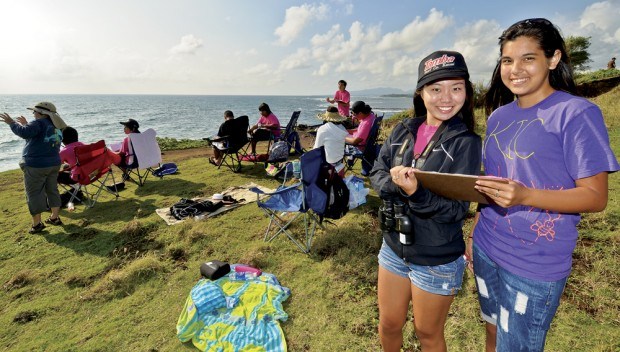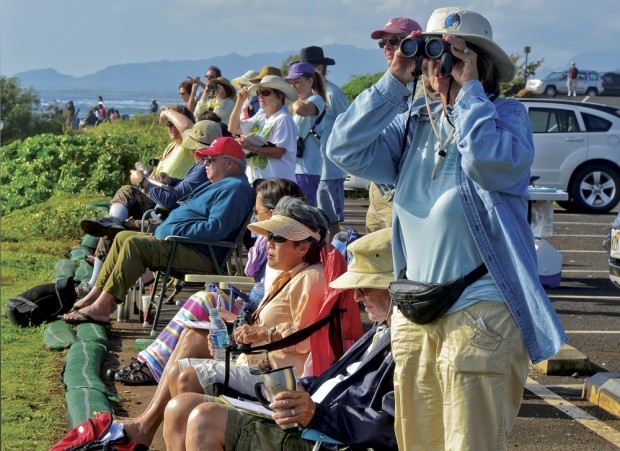Kaua‘i volunteers spotted more whales than their counterparts on Hawaii’s other islands during a weekend ocean count coordinated by the National Oceanic Atmospheric Administration (NOAA) Hawaiian Islands Humpback Whale National Marine Sanctuary.
“There were a lot of new people,” John Burger, volunteer site leader for the Kapa’a Lookout location, said. “This is one of the best viewings since I became a site leader.”
NOAA reported that Kaua‘i reported the highest average number of endangered humpback whales per 15-minute counting period on Saturday, with eight whales sighted. O‘ahu reported two whales sighted per 15-minute period, and the Big Island reported three.
During the count, participants tally humpback whale sightings and document the animals’ surface behavior, summarizing the information they collect in 15-minute increments. Two more ocean counts are scheduled Feb. 25 and March 31.
The Kapa‘a Lookout was one of 15 sites on Kaua‘i and 61 sites statewide participating in Saturday’s count.
More than 950 volunteers participated throughout Hawai‘i, NOAA spokeswoman Christine Brammer said in a news release.
‘It was great to see so many new volunteers taking part in this month’s count. The Sanctuary Ocean Count project provides a unique opportunity for the public to learn about humpbacks in Hawai‘i while participating in a monitoring effort,” Brammer said.
Kristen Sugihara, a member of the Kaua‘i High School Key Club, said she learned a lot about whales during her first experience as a whale counter. She and 12 other Key Club students joined Kaua‘i island coordinator Gabby Buist of Kapa‘a High School at the Kapa‘a site.
Jean Souza, NOAA’s t Kaua‘i programs coordinator, said 187 volunteers signed up on Kaua‘i, and that more than 370 people received whale education materials at high-traffic areas such as the Kapa‘a Lookout and Po‘ipu Beach Park.
“Nearly all of the Kaua‘i ocean count sites reported exceptionally good whale viewing conditions with lots of whales, clear skies and calm seas,” Souza said in an email. “The exception was the Pacific Missile Range Facility which had high surf, big swells, foam and haze, making for difficult whale watching conditions.”
Kapa‘a Lookout reported an average of eight sightings per 15-minute interval over the four-hour period. The highest number of sightings was from the Ninini Point Lighthouse, where site leaders Ken and Lynette Mizuo tallied 14 sightings, Souza said.
Other sites reporting high counts were Crater Hill in Kilauea (13), Kilauea Lighthouse (11), Mahaulepu-Makawehi (11) and Makahuena Point (12).
The sightings represent an increase over the Kaua‘i average in 2011, when six whales were reported during the January count. This month’s eight-whale average was last reported during the 2009 count.
As many as 12,000 humpback whales are found in Hawaiian waters each year, NOAA reports. Whales return to their birthplace each year between November and May, migrating from as far away as Alaska. Hawaiian waters provide critical breeding habitat for approximately two-thirds of the North Pacific stock of humpback whales.
Due to increased numbers of whales this time of year, boaters and other ocean users are asked to remain vigilant to avoid hitting or disturbing the endangered whales, which are protected by federal and state laws.
Scientific studies have shown the humpback whale population in Hawai‘i is increasing at an annual rate of approximately seven percent.
Data from the annual ocean count, over time, can be used to corroborate these findings, according to NOAA.
To register for the next ocean counts in February and March, or for more information about becoming a volunteer, visit http://sanctuaryoceancount.org or call 1-888-55-WHALE, ext. 253.
Souza said people should register early, because space is limited and people accepted as volunteers must attend a training class.
• Dennis Fujimoto, photographer and staff writer, can be reached at 245-3681 (ext. 253) or dfujimoto@ thegardenisland.com.



